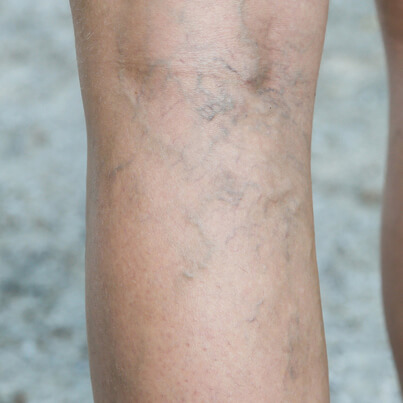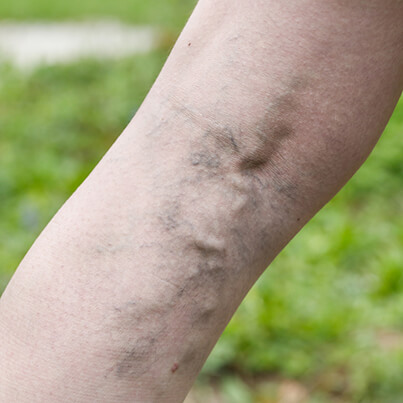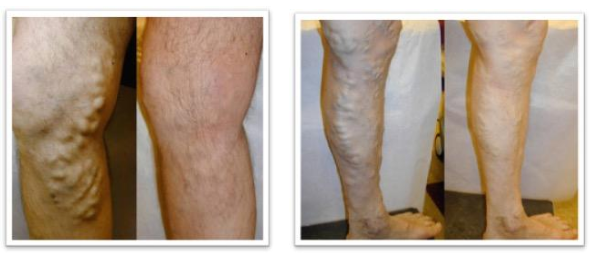Varicose Veins

Revolutionary Vein Treatments
Millions of Americans suffer from varicose veins. It’s estimated that half of all middle-aged adults in the United States are affected by noticeable, painful varicose veins.
Women are twice as likely as men to suffer from varicose veins and spider veins. Prominent veins can create not only aesthetic concerns and reduced confidence, but also larger health concerns.
Hinsdale Vein and Laser offers the southwest suburbs with an opportunity to receive minimally invasive, personally tailored varicose vein management. Dr. Amjad Alkadri employs state-of-the-art techniques to improve varicose veins with minimal downtime. Schedule a vein assessment and venous ultrasound to gain expert evaluation of your vein health.
Varicose Veins vs. Spider Veins
The two most commonly known vein problems are spider veins and varicose veins. They are two different classes of veins and are treated differently.
Spider veins are more superficial and can vary in color between red and blue. Some spider veins are painful.
Varicose veins are enlarged, bulging veins, that are typically twisted and rope like and blue in color.
Spider Veins (class 1)

Varicose Veins (class 2)

Causes
Varicose veins are enlarged, bulging veins that can develop from defective or diseased valves in your legs. When these valves can’t close the way they should, blood leaks back into the vein and pools there. Vein walls then swell, leading to varicose veins.
Some of the causes of varicose veins include:
- Inherited genetic predisposition
- History of blood clots
- Hormonal changes (pregnancy and hormone replacement)
- Previous venous surgery
- Obesity
- Standing or sitting for long period of time
Symptoms
Symptoms related to Varicose veins include:
- Leg swelling
- Itching and focal burning
- A feeling of heaviness in the leg at the end of the day
- Leg fatigue and burning
- Brown discoloration of Skin
- Leg pain and tenderness
- Visible varicose and spider veins
- Skin dryness and eczema
- ulcers near the ankle
Before and After Vein Treatment

Varicose Vein Treatment Options
There are many treatments for varicose veins offered at Hinsdale Vein and Laser:
- Endovenous laser ablation
- Chemical ablation using state of the art foam sclerotherapy (Varithena)
- Medical adhesive that results in closure of the unwanted veins (Venaseal)
- Mechanico-chemical ablation of the vein (MOCA)
- Ambulatory microphlebectomy
State-of-the-art Treatment Options
We are proud to be among the first in Chicago and surrounding area to provide the most clinically advanced and newest treatment options for your varicose veins.
EVLT (Endovenous Laser Treatment)
Dr. Alkadri inserts a thin fiber into the vein, whereby a laser light is emitted. The affected tissue reacts to the light energy, closing the vein so the blood can be re-routed to larger, healthier veins.
Phlebectomy
The doctor makes incisions in the skin to remove the varicose veins as part of a minimally-invasive procedure.
Varithena®
We are proud to be the first clinic in Illinois to offer this FDA approved foam, which reduces symptoms and improves the appearance of varicose veins. Because only an ultrasound machine is needed, the procedure is also minimally invasive and non-surgical.
VenaSeal™
We are also among the first in the Chicago area to provide this new FDA approved varicose vein closure system. It is non-tumescent and non-thermal, using an adhesive to close up the vein. The risk of nerve injury is lessened with this approach to treating small saphenous veins.https://youtu.be/1Wt8wkAMieM
Our treatments are safe and effective, and for many of them, no anesthesia is needed.
What to expect from a laser treatment
Laser vein treatments are minimally invasive. Under local anesthesia, a catheter is placed in the vein through a very tiny needle. The laser is passed through the catheter to the top of the site. After injection of additional anesthesia along the length of the vein, the laser is fired, and the catheter is withdrawn back out of the small puncture site. A compression stocking is applied.
This is considered a “lunch hour” procedure, and patients are expected to be able to walk immediately after (in fact you will be encouraged to walk to improve blood flow). Return to work or normal activities is typical after 24 hours. A feeling of tightness is expected for up to 2 weeks after the procedure and is a normal response to the laser.
What are the different steps of a treatment plan?
Initial exam:
- A full consult will be performed. If varicose veins are suspected, ultrasound vein mapping will be performed.
- If spider veins are suspected, a treatment plan will be offered which may include sclerotherapy and/or laser treatments.
Follow up consultation
- Dr. Alkadri will discuss your mapping results and will tailor a treatment plan that is suitable for you.
- We will file with insurance if your insurance requires pre-authorization.
- Our insurance experts will handle your insurance submission and will inform you of the decisions. Our insurance denials are extremely low because of our 20 years experience in the field of vein management.
Treatments
All the treatments we offer at Hinsdale Vein and Laser are covered by a majority of insurance carriers.
Available treatment options include:
- Endovenous laser ablation
- Chemical ablation using state of the art foam sclerotherapy (Varithena)
- Medical adhesive that results in closure of the unwanted veins (Venaseal)
- Mechanico-chemical ablation of the vein (MOCA)
- Ambulatory microphlebectomy
After the completion of your treatments, another ultrasound will be ordered and performed to evaluate closure of the unwanted veins.
Final Follow-up
- Dr. Alkadri will discuss your final results and will determine if any additional treatments are needed.
What are the pre-procedure instructions?
- Nothing to eat 12 hours before the scheduled procedure time
- Wear loose-fitting clothes
- Arrange for someone to accompany you to the appointment and take you back home
What are the post-procedure instructions?
- Compression bandage will be applied
- Class II compression stocking
- 20 minute walk
- Resume normal activities
- Ice as needed
- Avoid hot baths
- Avoid vigorous gym workouts
- Over the counter analgesics for any discomfort
Why are compression stockings so important after your treatment?
- Promote healing
- Keep veins compressed
- Reduce swelling
- Reduce symptoms
- Prevent deep vein clotting